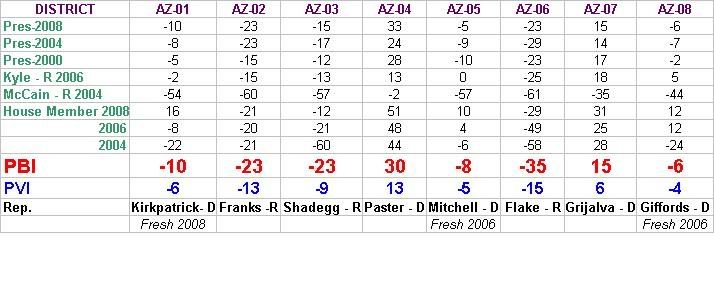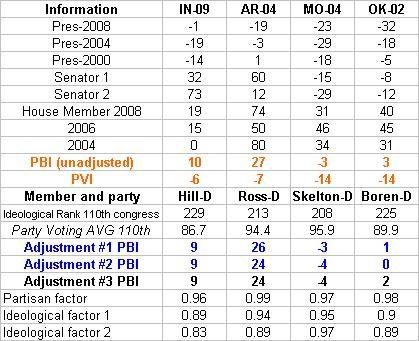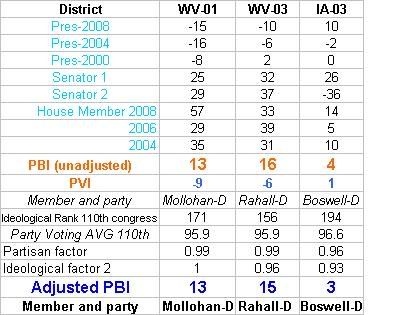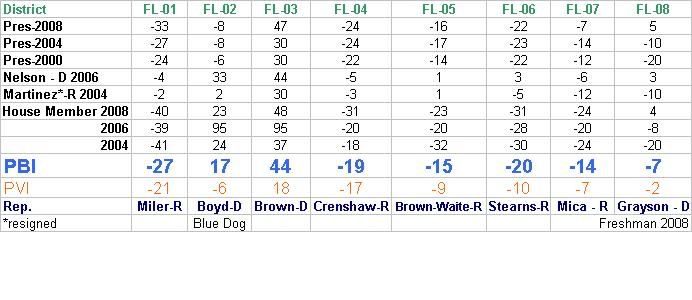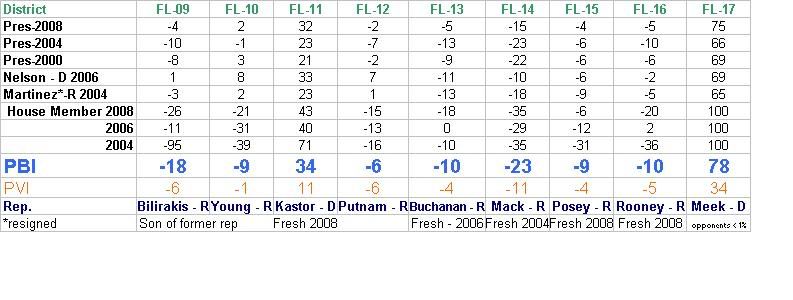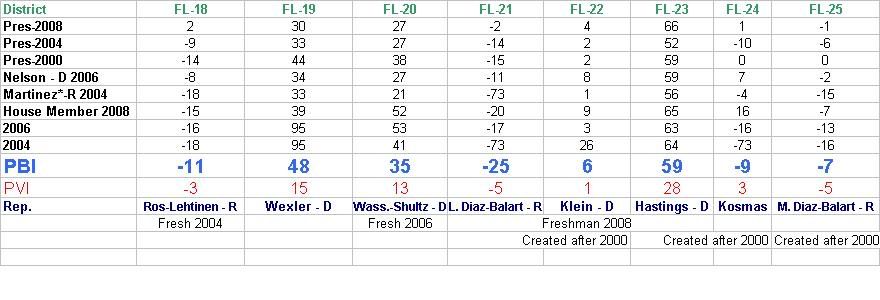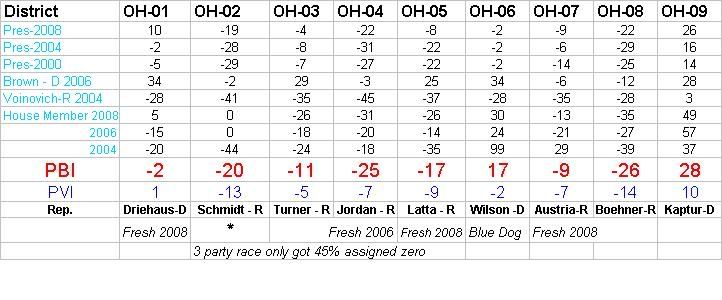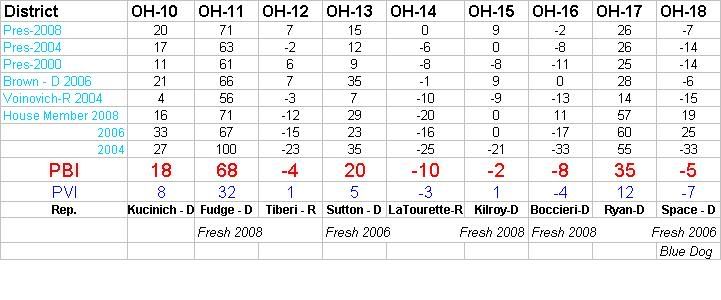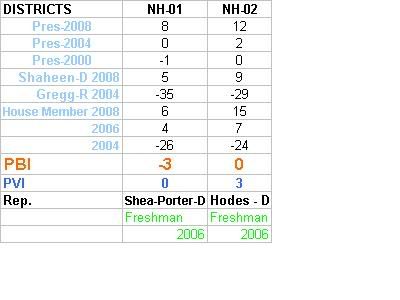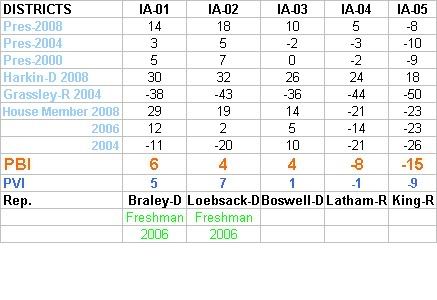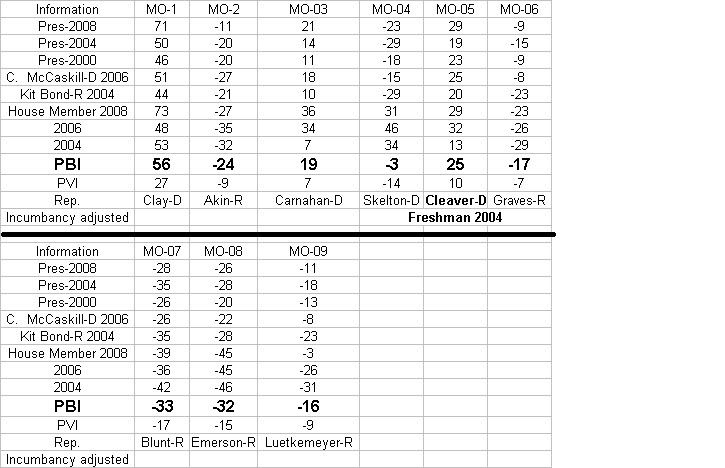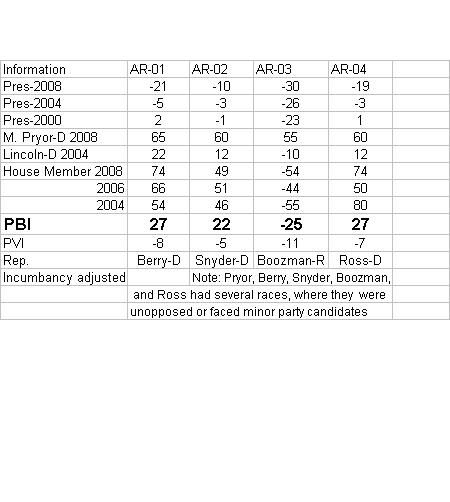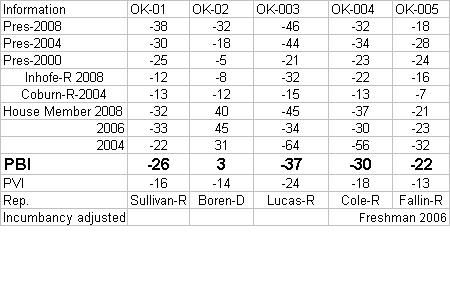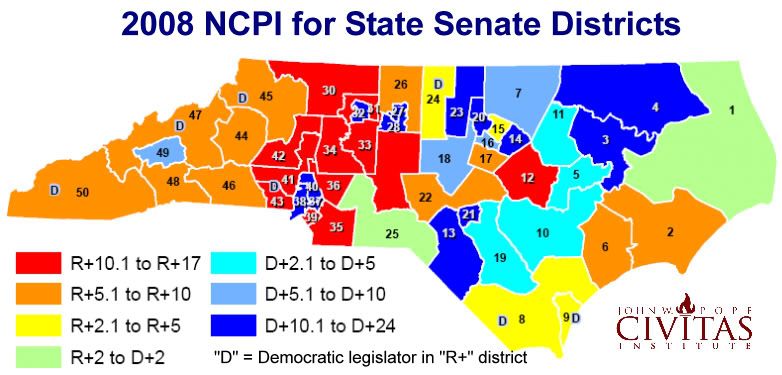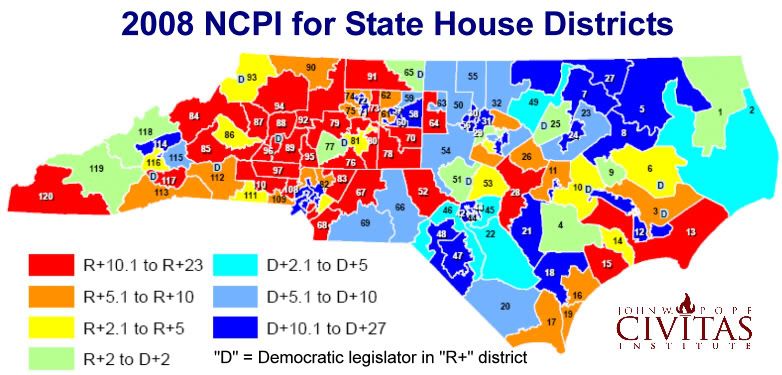This week we’re taking an in-depth, multi-part look at the 1994 election, as a means of divining what the 2010 election may hold for us in the House. To do so, we’re looking at some of the myths that seem to have taken hold regarding 1994; yesterday, for instance, we addressed the idea that 1994 was full of unpredictable, arbitrary wipeouts — which it wasn’t (our House Vulnerability Index did a spot-on job of predicting likelihood of losing compared with other Democrats).
Today, we’re looking at a couple more myths. They’re all interrelated — open seats and freshman status weigh heavily on the House Vulnerability Index — but it lets us slice and dice the data some new ways:
Myth 2) The losses in the 1994 election were disproportionately in the South, as historically Democratic districts that had started going Republican at the presidential level finally flipped downballot too.
No, not true. There’s plenty of reason to think this was the case (as I did until I started doing this research), as the 1992 round of redistricting rejiggered a number of districts in a way that was potentially harmful to moderate white Democrats elected by a coalition of African-Americans and working-class whites. With the creation of odd-shaped VRA-districts in a number of states, starting in 1992, moderate Democrats found themselves with the choice of either primaries against African-Americans in VRA districts, or against Republicans in much more conservative suburban/rural districts.
However, it turns out most of the impact from this occurred immediately in 1992, not 1994. For instance, the two Birmingham-area districts, which supported moderate Dems Claude Harris and Ben Erdreich, got turned into the mostly-white 6th and mostly-black 7th, which thus in 1992 turned into liberal Dem Earl Hilliard and conservative GOPer Spencer Bachus. Similarly, in 1992, long-time Democratic Rep. Walter Jones Sr. retired when he found himself in a now black-majority NC-01; his son, Walter Jones Jr., lost the Dem primary to Eva Clayton. In fact, this gave rise to perhaps the only Dem loss in 1994 that seems directly related to the VRA gerrymander: Rep. Martin Lancaster survived the 1992 election reasonably well despite having lost many of NC-03’s African-American voters to next-door NC-01, but in 1994 faced off against the younger Jones, now a Republican (and whose dad had represented many of NC-03’s voters prior to the redistricting), and lost.
It’s possible that Stephen Neal in NC-05, who got a nastier district in 1992 after having the black parts of Winston-Salem moved into the newly-formed NC-12 and then won by only 7% in 1992, may have felt compelled to hit the exits in 1994 primarily because he didn’t relish the task of trying to hold the district. At R+4 at the time, though, that wasn’t a particularly bad district. Norm Sisisky’s VA-04 also seems to have gotten worse post-1992 because of the gerrymandering of VA-03, but he still survived 1994 unscathed and held that district until his 2001 death. (If you can think of any other examples, please discuss in the comments. For instance, the creation of GA-11 or FL-03 may have had some consequences I’m not thinking of.)
The South (as defined by the US Census with one exception — I’m treating Maryland and Delaware as Northeast) did lose more Democratic seats than any other region of the country, that much is true. But that’s mostly because there were more Democratic seats in the South than any other region of the country; in terms of the overall win/loss percentage, the Democrats actually fared slightly better in the South than in the Midwest or West. In addition, much of what happened in the South was because of open seats; there were certainly more open seats in the South, while the South’s freshmen and veterans tended to fare better than those in the Midwest and West. There may be something of a chicken and egg effect here — old-timer Reps. in the South may have sensed trouble a-brewin’ and gotten out of the way, meaning that the inevitable losses took the form of open seats instead of defeated veterans — but, as we saw yesterday, open seats are the hardest to defend and the mass retirements (15 in the South) seemed to compound the disaster.
The one region where the Democrats performed notably better than the norm was the Northeast (their casualty rate in defensive races was only 11%, compared with 22% overall). That’s largely because there are so many safely-blue districts in the major cities of the Northeast; there were fewer suburban or rural seats there, which were the types that the GOP picked up in 1994. (The Dems faring comparatively well in 1994 in the Northeast helped pave the wave for their near-total dominance there now, as they gradually picked up suburban districts that leaned blue at the presidential level over the following decade.)
— |
South |
Mid-
west |
West |
North-
east |
Nationwide |
|---|
Seats
Defended |
86 |
61 |
55 |
54 |
256 |
All Seats
Won |
67 |
45 |
40 |
48 |
200 |
All Seats
Lost |
19 |
16 |
15 |
6 |
56 |
Casualty
Rate |
22% |
26% |
27% |
11% |
22% |
All Open
Seats |
15 |
8 |
4 |
4 |
31 |
Open Seats
Lost |
11 |
6 |
3 |
2 |
22 |
Open Seat
Casualty Rate |
73% |
75% |
75% |
50% |
71% |
All
Freshmen |
22 |
14 |
17 |
13 |
66 |
Freshmen
Lost |
3 |
4 |
7 |
2 |
16 |
Freshmen
Casualty Rate |
13% |
29% |
41% |
15% |
24% |
All
Veterans |
49 |
39 |
34 |
37 |
159 |
Veterans
Lost |
5 |
6 |
5 |
2 |
18 |
Veteran
Casualty Rate |
10% |
15% |
15% |
5% |
11% |
This table also brings us to another myth which we’ll talk about today:
Myth 3) Veterans fell victim to the slaughter just as much as newcomers.
No, not at all. (This myth — which may have arisen just because of the sheer shock of losing Foley and Rostenkowski — we sort of discussed yesterday, in the context of how the losses that were suffered in 1994 were largely predictable. That’s because the House Vulnerability Index that I’ve developed places the highest level of vulnerability on open seats, and then tends to rate frosh as next-most-vulnerable, generally because they usually win their initial election by narrower margins than do veterans. But we’ll talk about it some more today.)
As you can see, the safest place to be in 1994 was among the ranks of veterans (and you’d be extra-safe as a veteran in the Northeast). The GOP picked up the large majority of open seats, and cut a decent-sized swath through the freshmen, but 89% of the veterans lived to fight again. In fact, as you’ll notice from the lists above, the numbers of the freshmen who lost in actually competitive seats (based on Cook Partisan Voting Index) nearly rivals the rate at which open seats fell, if you factor in the large number of freshmen in newly-created 1992 VRA seats that weren’t going to go Republican under any circumstances. Compare the survival rate among freshmen in the South (where most were in new VRA seats) with the survival rate among freshmen in the West (where there was little creation of VRA seats, compounded by the Dems’ particularly egregious — and, to me, rather inexplicable — collapse in Washington state).
If you look at the list of winners and losers in each region in the lists that are over the fold, you can see the point in the PVIs where you shift from D+s to R+s as being the point where open seats and freshmen started falling. In the interest of space, I didn’t list all veterans who survived, but, by contrast, there were many who did so even while in seriously GOP-leaning turf. Was that because they hedged their bets by voting against big-ticket Democratic agenda items like the Clinton budget and the assault weapon ban, which were presumably unpopular in their conservative districts? Well, that’s something we’ll talk about in the coming days.
Here’s the list of who goes where. Open seats, for our purposes, includes races where the incumbent was knocked off in a primary. (And I’m not listing veterans who won, in the interest of space.)
South open seats won: TX-18 (D+22, ex-Washington), TX-10 (D+8, ex-Pickle), KY-03 (D+3, ex-Mazzoli), TX-25 (D+3, ex-Andrews)
South open seats lost: OK-02 (D+3, ex-Synar), TN-04 (R+2, ex-Cooper), NC-05 (R+4, ex-Neal), TN-03 (R+5, ex-Lloyd), OK-04 (R+7, ex-McCurdy), NC-02 (R+7, ex-Valentine), MS-01 (R+7, ex-Whitten), GA-08 (R+8, ex-Rowland), SC-03 (R+13, ex-Derrick), FL-15 (R+14, ex-Bacchus), FL-01 (R+20, ex-Hutto)
South freshmen won: FL-17 (D+25, Meek), AL-07 (D+21, Hilliard), LA-04 (D+19, Fields), TX-30 (D+19, Johnson), NC-12 (D+18, Watt), VA-03 (D+18, Scott), GA-11 (D+17, McKinney), FL-23 (D+16, Hastings), NC-01 (D+15, Clayton), SC-06 (D+14, Clyburn), GA-02 (D+12, Bishop), TX-28 (D+11, Tejeda), TX-29 (D+11, Green), FL-03 (D+10, Brown), MS-02 (D+9, Thompson), AR-01 (D+7, Lambert), FL-20 (D+3, Deutsch), FL-05 (R+1, Thurman), GA-09 (R+14, Deal)
South freshmen lost: KY-01 (D+0, Barlow), VA-11 (R+5, Byrne), GA-10 (R+10, Johnson)
South veterans lost: TX-09 (D+5, Brooks), NC-04 (D+1, Price), TX-13 (R+5, Sarpalius), NC-03 (R+8, Lancaster), GA-07 (R+11, Darden)
Midwest open seats won: MO-05 (D+13, ex-Wheat), MI-13 (D+4, ex-Ford)
Midwest open seats lost: OH-18 (D+2, ex-Applegate), MN-01 (D+1, ex-Penny), IL-11 (R+1, ex-Sangmeister), MI-08 (R+1, ex-Carr), KS-02 (R+2, ex-Slattery), IN-02 (R+8, ex-Sharp)
Midwest freshmen won: IL-01 (D+34, Rush), IL-02 (D+32, Reynolds), IL-04 (D+19, Gutierrez), WI-05 (D+13, Barrett), MI-05 (D+5, Barcia), MO-06 (D+3, Danner), MI-01 (D+0, Stupak), MN-02 (R+0, Minge), OH-13 (R+1, Brown), ND-AL (R+7, Pomeroy)
Midwest freshmen lost: WI-01 (D+3, Barca), OH-19 (R+0, Fingerhut), OH-01 (R+2, Mann), OH-06 (R+4, Strickland)
Midwest veterans lost: IL-05 (D+5, Rostenkowski), IA-04 (D+4, Smith), IN-08 (R+2, McCloskey), KS-04 (R+6, Glickman), NE-02 (R+8, Hoagland), IN-04 (R+13, Long)
West open seats won: CA-16 (D+12, ex-Edwards)
West open seats lost: OR-05 (D+2, ex-Kopetski), WA-02 (D+2, ex-Swift), AZ-01 (R+9, ex-Coppersmith)
West freshmen won: CA-37 (D+29, Tucker), CA-30 (D+18, Becerra), CA-33 (D+18, Roybal-Allard), CA-06 (D+15, Woolsey), CA-14 (D+11, Eshoo), CA-17 (D+11, Farr), AZ-02 (D+11, Pastor), CA-50 (D+7, Filner), OR-01 (D+4, Furse), CA-36 (R+3, Harman)
West freshmen lost: CA-01 (D+7, Hamburg), WA-09 (D+3, Kreidler), WA-01 (D+2, Cantwell), CA-49 (D+1, Schenk), AZ-06 (R+4, English), WA-04 (R+7, Inslee), UT-02 (R+8, Shepherd)
West veterans lost: WA-03 (D+4, Unsoeld), NV-01 (D+1, Bilbray), WA-05 (D+1, Foley), CA-19 (R+4, Lehman), ID-01 (R+9, LaRocco)
Northeast open seats won: PA-02 (D+26, ex-Blackwell), PA-20 (D+11, ex-Murphy)
Northeast open seats lost: ME-01 (R+0, ex-Andrews), NJ-02 (R+4, ex-Hughes)
Northeast freshmen won: NY-08 (D+28, Nadler), MD-04 (D+24, Wynn), NY-12 (D+22, Velazquez), NY-14 (D+20, Maloney), MA-01 (D+10, Olver), PA-04 (D+10, Klink), NJ-13 (D+7, Menendez), MA-05 (D+2, Meehan), NY-26 (D+2, Hinchey), PA-15 (R+1, McHale), PA-06 (R+7, Holden)
Northeast freshmen lost: NJ-08 (R+1, Klein), PA-13 (R+4, Margolies-Mezvinsky)
Northeast veterans lost: NH-02 (R+5, Swett), NY-01 (R+6, Hochbrueckner)
